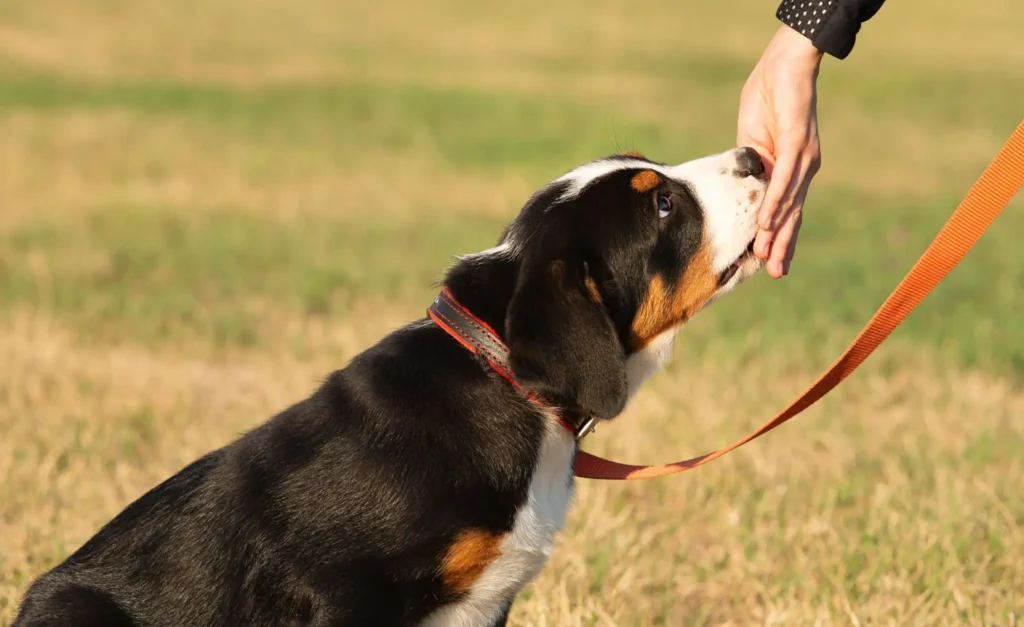Welcome to our complete guide to Dog E-Collar training, which will help you bring out your pet’s full potential. Dog E-collars are a controversial way to train your dog, but if you use them correctly, they can help you train your dog.

We care about helping people and dogs get along well and get along well together. In this piece, we’ll give you valuable information, techniques, and tips on using E-Collars as a training tool. Let’s jump right in and learn about Dog E-Collar training!
Understanding Dog E-Collar Training
What is an Dog E-Collar?
An Dog E-Collar, which is short for “electronic collar,” is a device that helps dog owners learn and talk to their pets. It has a collar with a receiver and an emitter that you hold in your hand. The receiver is worn around the dog’s neck. It has different settings that let owners send different amounts of stimulation, such as vibrations, sounds, or mild electric pulses.
Purpose of Dog E-Collar Training
Dog E-Collars are made to help train dogs by sending them clear, consistent messages. When used right, they can help reinforce commands, stop unwanted habits, and give you more control when your dog is off-leash. Dog E-Collars are great for teaching dogs that are stubborn, easily distracted, or have a strong desire to hunt.
Getting Started with Dog E-Collar Training
Step 1: Choosing the Right E-Collar
Choosing the right E-Collar for your dog is very important to ensure it is safe and efficient. When making your choice, think about the following:
Size and Weight:
Make sure the Dog E-Collar is the right size and weight for your dog. Collars that don’t fit right can be uncomfortable or even harmful.
Range and Signal Quality:
Look for Dog E-Collars with enough range for your training needs. Choose models that send out a strong and steady signal.
Features and Settings:
Look at the features and settings that are offered. Some Dog E-Collars have different amounts of stimulation, tones, and vibrations that you can use to match your dog’s personality and training needs.
Step 2: Introducing the Dog E-Collar
For your dog to accept and like the E-Collar, you must show how to use it properly. Do these things:
Desensitizing:
Gradually get your dog used to wearing the E-Collar. Start by putting it loosely around their neck for short amounts of time. Over a few days, keep it there longer and longer.
Use positive reinforcement:
When the Dog E-Collar is around, the dog should have good things happen. While your dog is wearing the collar, give them treats, praise, and time to play.
Avoid Misuse:
Do not apply the E-Collar for punishment or to promote fear in your dog. It should always be linked to good communication and teaching.
Step 3: Basic E-Collar Training Techniques
Once your dog is used to wearing the E-Collar, you can use it as part of your training. Here are some basic techniques to get you started:
Get your dog used to the collar:
Teach your dog to associate the stimulation from the Dog E-Collar with specific orders. Pair the stimulation with a verbal order, and reward them when they do what you want.
Positive Reinforcement:
Use treats, praise, and love along with the E-Collar to teach your dog good things. This supports the things you want your dog to do and makes the relationship between you and your dog stronger.
Consistency and Timing:
In E-Collar training, consistency is very important. Use the same orders every time, and when stimulation is needed, give it right away. This lets your dog know what you want from them.
Advanced Dog E-Collar Training Techniques:
Recall Training
For effective control when the dog is off-leash, recall training is a must. Step by step guide for you:
Build Foundation:
Start recall training in a familiar, controlled atmosphere with minimal distractions. Use a long rope and an E-Collar to teach your dog to come when called.
Gradual Distance Increase:
Move farther away from your dog while they are still responding well to your calls. Use the E-Collar to tell your dog again what you want him to do if dog doesn’t listen.
Add distractions:
Slowly add distractions to make the situation more like real life. Use the E-Collar to teach your dog the recall word and reward him when he does it right.
Off-Leash Training:
Once your dog reliably comes when called while on a long leash, you can slowly switch to off-leash training while still using the E-Collar to reward good behavior.
Behavior Correction
Dog E-Collars can help stop from doing things they shouldn’t. But use them responsibly and morally. Here are some rules to follow:
Figure out the Behavior:
Figure out the exact behavior you want to change, such as yelling, jumping, or digging too much.
Timing and Consistency:
Use the Dog E-Collar to stop the bad behavior right when it happens. Combine the stimulation with a verbal order to make the animal link it to the behavior you don’t want.
Redirect and reward:
When you stop the bad behavior, turn your dog’s attention to something else you want him to do. Praise and treats can help strengthen the behavior you want to see.
Conclusion
Dog E-Collars aid training and communication. Use these tips to build a great bond with your dog. Train well, use E-Collar right, and get good results. Use this tool, be patient, and enjoy unlocking your pet’s full potential!
Dog E-collars are a last resort. Training your dog without an e-collar is the best choice. If other methods fail, an e-collar can help.
E-collars can train dogs safely and effectively. Research before choosing an e-collar brand. Be patient and consistent in training. Train your dog to behave well in your family with time and effort.



